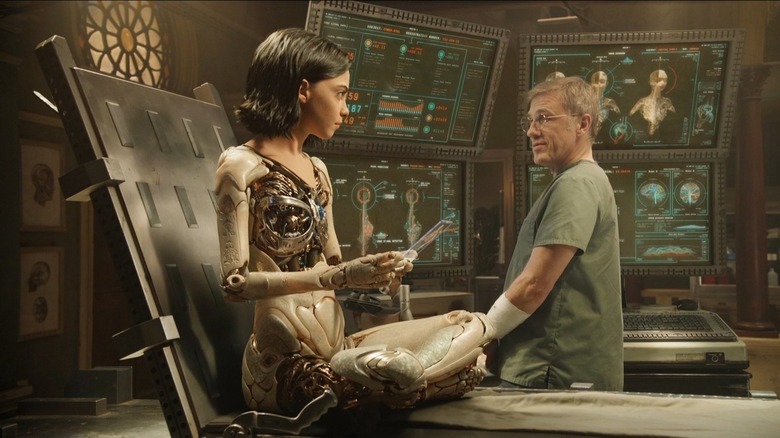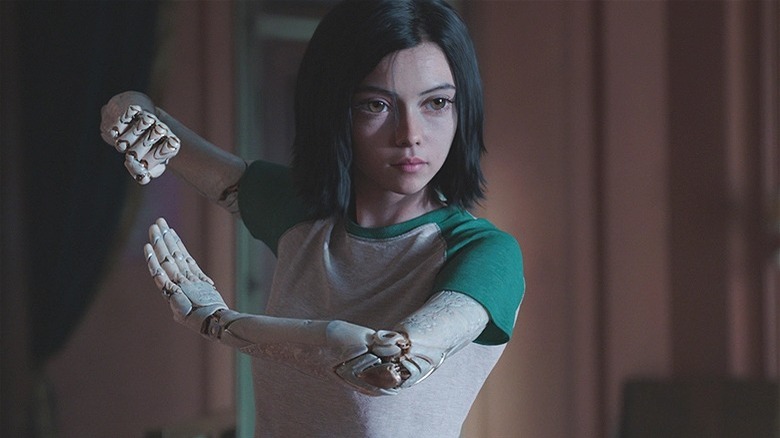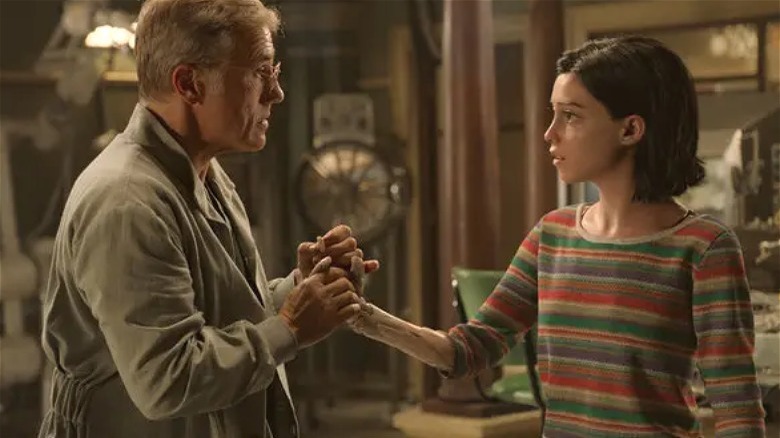James Cameron Was The Only Audience Alita: Battle Angel Set Out To Impress
When it comes to charting out meticulous plans for a movie concept, James Cameron is always one step ahead of the game. Cameron is the kind of director who would rather wait for the right circumstances than jump in on an opportunity with unfavorable odds. This led to projects being shelved until the right kind of technology came along, as it was important for Cameron to actualize his vision exactly the way he intended. As a result, when Cameron decided to adapt the Japanese cyberpunk manga "Gunnm" (also known as "Alita: Battle Angel"), he had to wait for 20-odd years for the right kind of technology to evolve.
Although Cameron was supposed to direct this immensely ambitious project, he got caught up in making "Avatar," which ushered in a fresh wave of filmmaking that pioneered computer animation using real actors. However, Cameron turned to long-time friend Robert Rodriguez to spearhead this massive, high-stakes project, passing on a 186-page screenplay and 600 pages of notes to the "El Mariachi" director. Although Cameron and Rodriguez have completely different directing styles and aesthetics, their vision for "Alita: Battle Angel" was realized after Rodriguez was able to transform Cameron's long-gestating script into an adaptable screenplay.
Although Rodriguez was aware of the need to get "Alita: Battle Angel" right, he was not doing it to impress studio executives. The director's sole objective was to bring Cameron's vision for "Alita" to life in all the right ways while creating a story that resonated with audiences on an emotional level. "Alita: Battle Angel" is Rodriguez's homage to Cameron's legacy in filmmaking; it is a labor of love that uses spectacle to tell a moving dystopian story.
'I was making it for Jim'
The protagonist of the film, Alita, looks doll-like, with manga eyes and animated expressions. In order to achieve this without making it look too unrealistic, a mix of live-action and computer-generated imagery was used. Although the fate of the film hinged on how the audience would respond to its titular character, Rodriguez focused on ironing out the kinks in a way that made sense to him and Cameron. Rodriguez explained the process in an interview with The Irish Times:
"We did worry about how it would all fit together. We kept the line in there that she wasn't completely human. Because even a few years ago, we couldn't have made her look like she does... I wasn't making a movie for Fox. I was making it for Jim. And Jim and I are buddies. So if we liked it, that's what we did. I felt like I had my own Terminator with me to protect me. It was pretty much like working on an independent film."
Apart from having access to the right kind of technology that made Alita's semi-CGI appearance possible, actress Rosa Salazar (who plays Alita) was instrumental in bringing the character to life on the big screen. Salazar was able to portray Alita's complex emotions in a way that viewers could identify with, despite the fact that she wasn't entirely human.
"Alita: Battle Angel" features futuristic cyborg suits, cool weapons like the Damascus blade, and extreme sports like Motorball. However, Alita is the beating heart of the film, and it is her bond with the other characters that provides the cyberpunk narrative with an emotional edge. Rodriguez channeled what Cameron did best: using technology to create fantastical worlds that would seem rather empty without characters worth rooting for.
Why Alita: Battle Angel is so beloved
Rodriguez deserves full credit for bringing a shelved project out of gestation and understanding Cameron's intentions for "Alita" as a cyberpunk action film with heart. Motion-capture technology was an integral part of the film, as it not only informed its immense world-building but also shaped the inner world of its titular character. As Cameron is adept at hunting out the right kind of technology for his films, Rodriguez was immensely inspired by his approach and did his best to channel the "Avatar" director.
This, of course, was infused with Rodriguez's own outlaw aesthetics that helped polish the ambitious premise of the film into a workable project. In the interview linked above, Rodriguez talks about how Cameron does not make "typical Hollywood films" that sideline characters for sheer spectacle and how he had to deliberately channel Cameron for "Alita:"
"Jim Cameron comes from the same place as me. He comes from genre. It's just that he has expanded out and into this whole other thing. He doesn't make typical Hollywood films either. Look how long Titanic spends on the characters before anyone even mentions an iceberg...So for this film, I had to think like I was making a James Cameron movie; I couldn't make it like a Robert Rodriguez movie."
Rodriguez's admiration for Cameron's filmmaking clearly trickled into "Alita." Moreover, Rodriguez was devoted to character-building as much as world-building, and waiting for the right kind of technology clearly worked in favor of the film. Also, due to Cameron's involvement as producer, "Alita: Battle Angel" became the film that is widely loved today. Needless to say, everyone involved deserves every bit of praise.


